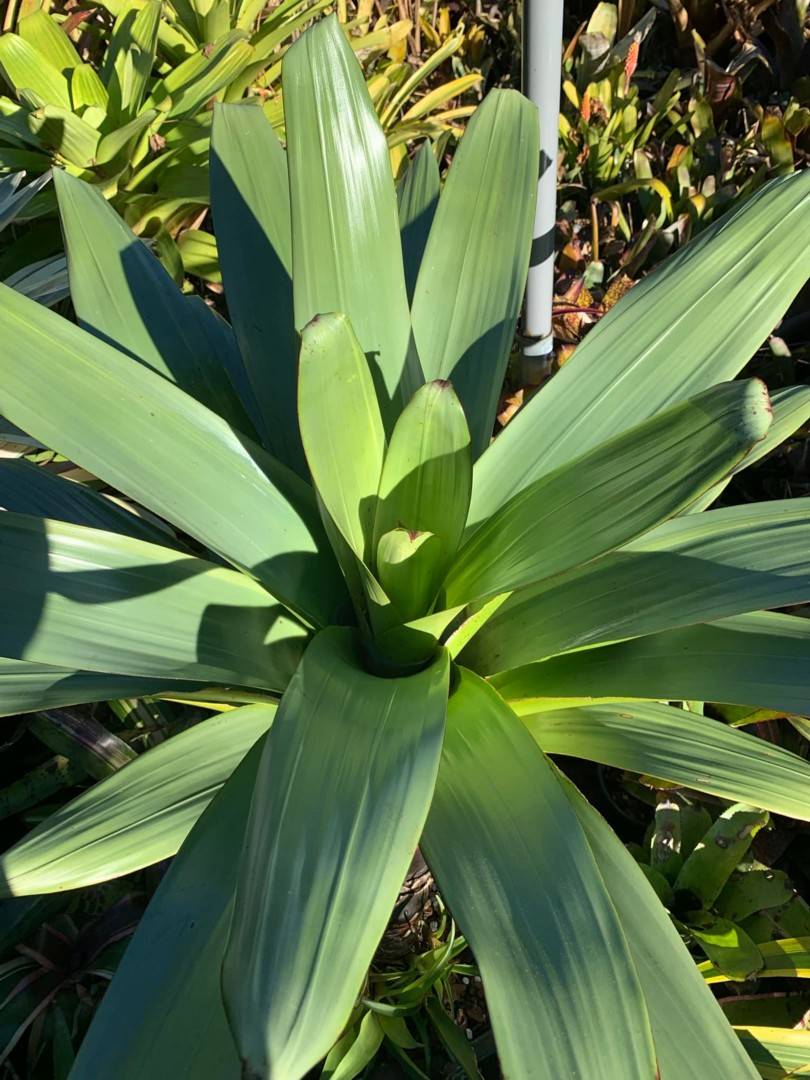

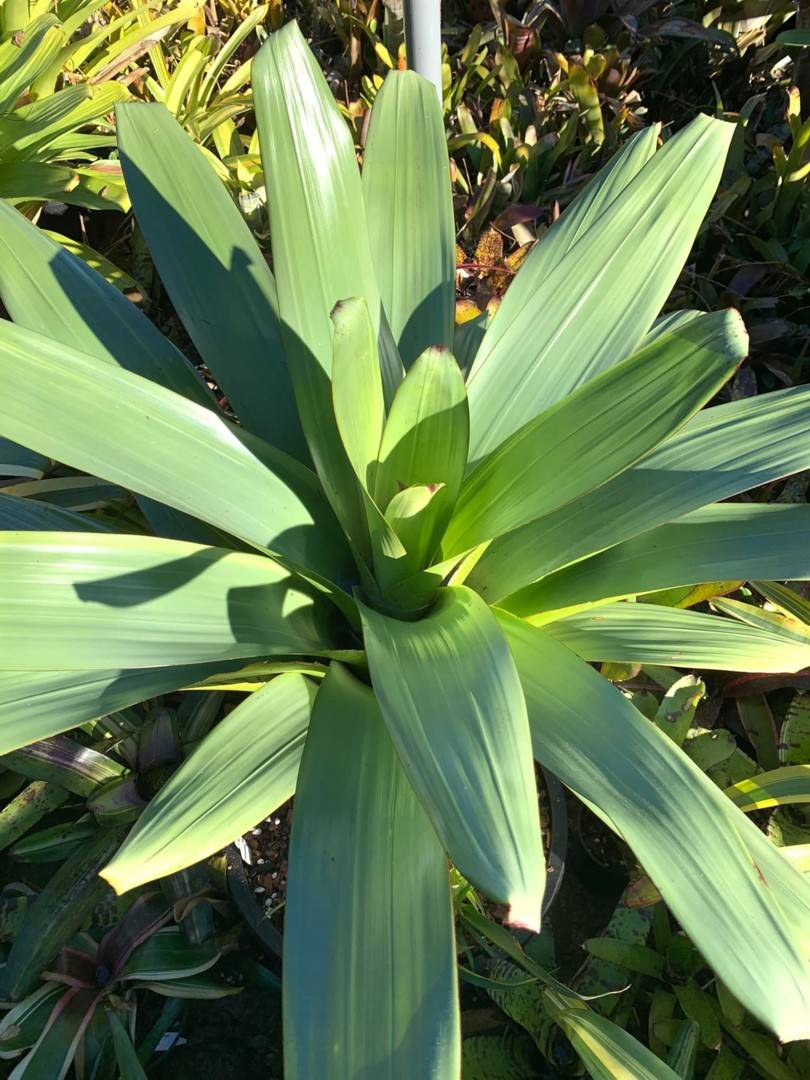

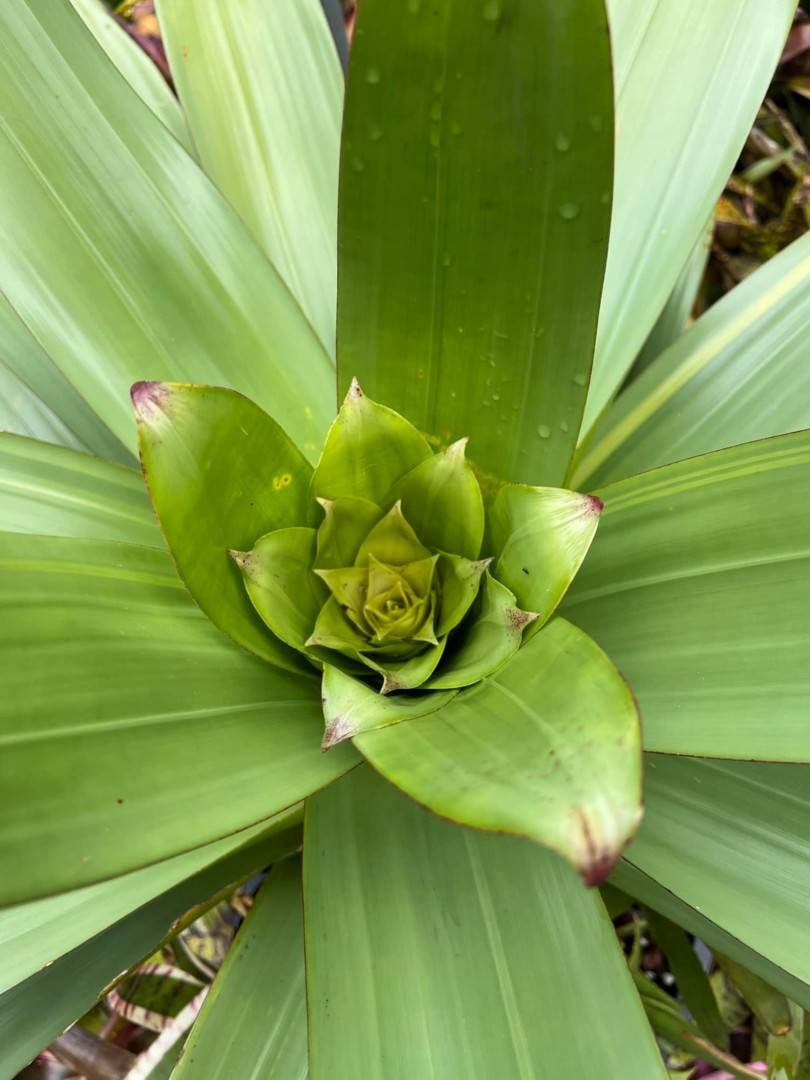



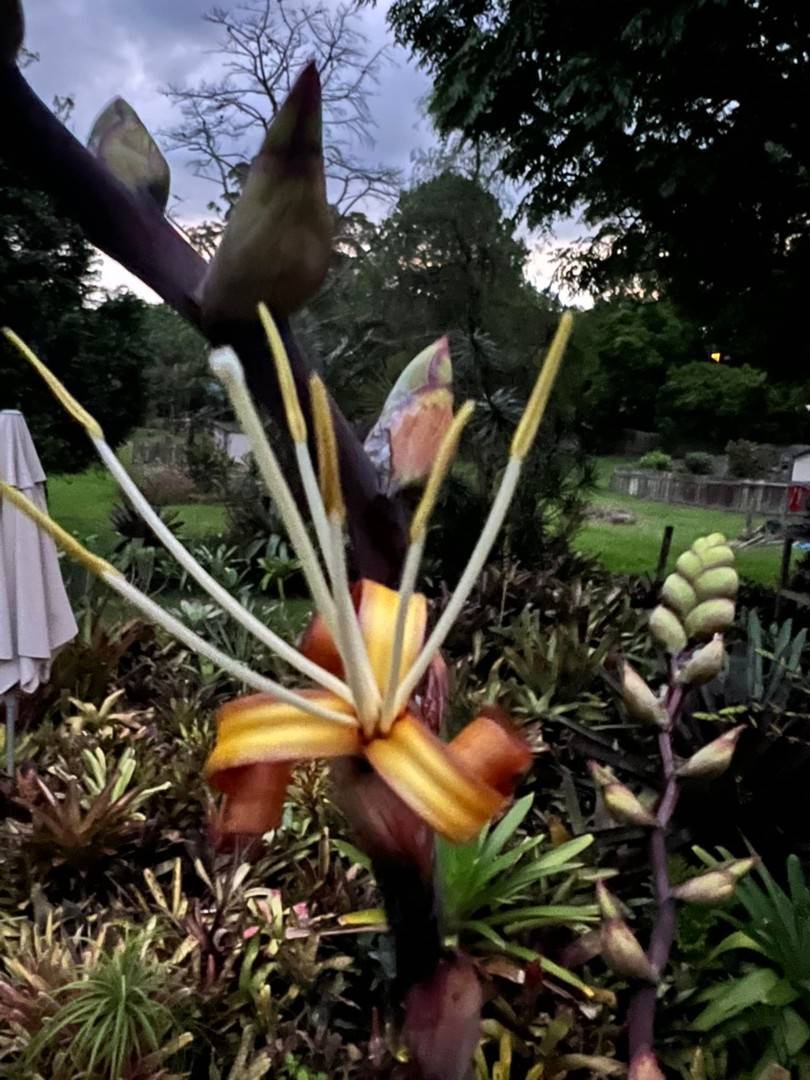
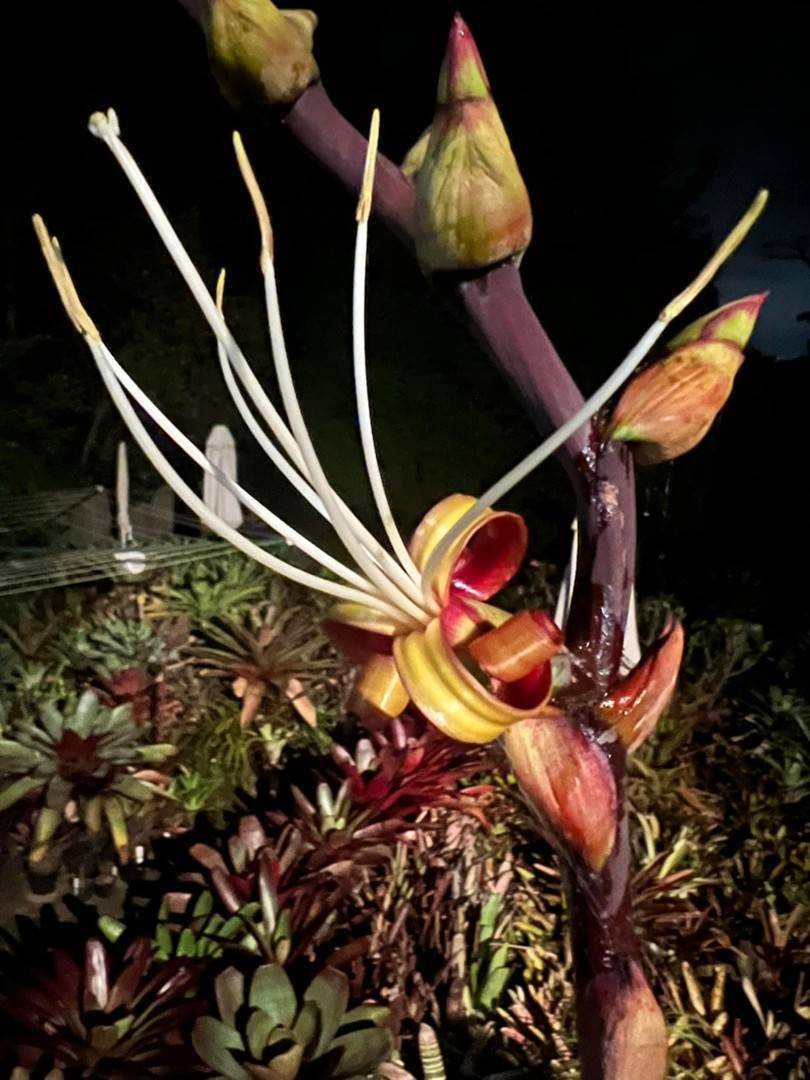

RUPICOLA, ca. 3 m alt., propagando-se por brotacoes axilares, curto-caulescente.
DIAGNOSE. Alcantarea abacta is closely related to Alcantarea trepida Versieux & Wand. but differs by the remote peduncle bracts, basal flowers distinctly long pedicellate, and longer
petals, petal appendages and stamens.
DISTRIBUICAO, ECOLOGIA E CONSERVACAO . Alcantarea abacta so e conhecida de inselbergs entre fragmentos de mata atlantica e pastagens, entre 500-600 m.s.m., em Padre Paraiso, nordeste de Minas Gerais. Forma densas populacoes na regiao da localidadetipica. Nao ha registros dentro de unidades de conservacao.
FENOLOGIA. Floresceu em cultivo entre dezembro e janeiro.
ETIMOLOGIA. Abacto refere-se a aborto ou ao uso da forca para se obter algo de forma violenta. Nesse caso, faz referencia aos ramos laterais da inforescencia abortados e ao pedunculo e inflorescencias alongados com bracteas remotas que, se comparados a suposta especie vizinha (A. trepida), sugerem que a inflorescencia tenha sido forcosamente distendida. Ainda, a forma da inflorescencia lembra uma arma, lanca ou tridente.
DISCUSSAO. Alcantarea abacta possui nitido relacionamento com as demais especies do complexo A. extensa, especialmente com A. trepida (Versieux & Wanderley 2010a), da qual difere pela forma de propagacao por brotacoes axilares (vs. basais), caule curto (vs. desenvolvido), laminas, em geral mais curtas, ate 45 cm (vs. > 40 cm) e sem linha vinosa nas margens (vs. com linha), pedunculo mais longo (1.3 vs. ate 1.1 m) e mais fino, disposicao das bracteas do pedunculo, que sao remotas e mais justapostas. ao eixo (eretas a suberetas e nao infladas na base vs. suberetas a recurvadas e infladas na base), presenca de um pedicelo bem distinto (15-25 mm) nas flores basais e tamanho geral da flor.
MATERIAL EXAMINADO: Brasil. MINAS GERAIS: Padre Paraiso, f. cult. 14 Jan 2010, L. M. Versieux 491 (UFRN, SP).
ROSETA infundibuliforme, fitotelma desenvolvido. FOLHAS ca. 30, suberetas a eretas;
BAINHA ca. 23 x 14 cm, oval, castanho-escura a bege ou alvacenta em ambas as faces in vivo, densamente marrom-lepidota em ambas as faces, coriacea, margens membranaceas, hialino-amareladas;
LAMINA 34-45 x 7-8 cm, ligulada, verde concolor (in. cult.) a verde amarelada (habitat), marcescentes, sem qualquer vestigio de maculas vinosas ou cera epicuticular em ambas as superficies, glabrescente abaxialmente, de glabra a esparsamente lepidota em direcao ao apice adaxialmente, reta a levemente arqueada, coriacea, distintamente nervada, com nervuras proeminentes, margens verdes;
APICE DA LAMINA obtuso-acuminado, verde, raramente com maculas vinosas, em geral recurvado.
PEDUNCULO ca. 135 x 1.8-2.5 cm, ereto, reto, cilindrico, verde claro, glabro, distintamente nervado; entrenos 5-6.5 cm (proximais),7.5-9 cm (distais);
BRACTEAS proximais: ca. 20 x 8 cm, ovais, eretas a suberetas; as medianas e distais: ca. 6 x 5.5 cm, remotas, ovais a largo-ovais, apice atenuado a acuminado, verdes com margens e apice vinosos, a totalmente vinosas, ou verde-amarronzadas, geralmente cerosas e glabras na face abaxial, esparsamente lepidota em direcao ao apice e lustrosas na face adaxial, eretas a suberetas, involutas, acumulando pouca agua (ou mucilagem) na base, distintamente nervado-rugosas, coriaceas, margens membranaceas, hialino-vinosas.
INFLORESCENCIA ca. 1 x 0.7 m, composta, panicula, contorno em geral obovado-eliptico, ereta; entrenos da raque 7-9 cm;
BRACTEA PRIMARIA 4-5 x 4.5 cm, Iargo-oval a triangular, apice agudo, inconspicuamente mucronado por ca. 3 mm, da mesma cor que as bracteas do pedunculo, avermelhadas a acastanhadas in vivo, em geral lustrosa, glabrescente abaxialmente, subdensamente lepidota adaxialmente, involuta, subereta, muito mais curta que a base esteril do pedunculo lateral, distintamente
nervado-rugosa, coriacea, margens membranaceas, paleaceas quando senis; RAMOS DA
INFLORESCENCIA 3, 20-35-floridos, suberetos, o terminal ereto;
PEDUNCULOS LATERAIS 13-17 x 1-1.5 cm, cilindricos, verdes, glabros;
BRACTEAS ESTEREIS 3.5-4 x 4.2 cm, 2 ou 3 variando no mesmo individuo, orbicular a largo-oval, apice obtuso apiculado, marrom-avermelhadas, levemente cerosas, glabras abaxialmente,
subdensamente lepidotas adaxialmente, suberetas, distintamente nervadas, ecarinadas, coriaceas, margens hialino-avermelhadas, membranaceas;
RAQUILA 35-80 cm, quase reta, verd., glabra; entrenos 1.5-4.5 x 0.8-1.2 cm, quase quadrangular em secao transversal;
BRACTEA FLORAL 3.8-4.5 x 4.2-4.8 cm, largo oval a quase triangular, apice obtuso, verde com margens vinosa, verde levemente acastanhado ou castanho-vinosas, in vivo, glabra abaxialmente, subdensamente marrom-lepidota em direcao ao apice adaxialmente, envolvendo parcialmente 2/3 do calice, subereta a patente, finamente nervada nos bordos e rugosa principalmente no centro in sicco, coriacea, ecarinada, margens membranaceas, hialinas in vivo.
FLORES inodoras, disticas, antese noturna, pre-floracao levemente espiralada, as proximais 15-25 mm-pediceladas;
SEPALAS 4-4.3 x 2-2.3 cm, oboelipticas, apice obtuso, simetricas, excedendo em ca. 1 cm as bracteas florais, verdes a verde-amareladas, glabra abaxialmente, esparsamente lepidotas adaxialmente, carticeas, ecarinadas, margens membranaceas, hialino-vinosas in vivo;
PETALAS 13-14 x 0.9-1 cm, liguladas, apice obtuso, constritas ao redor do apice das sepalas, com maculas e pequenos tracos vinosos na face abaxial, amarelas adaxialmente, recurvadas e pouco espiralados;
APENDICES PETALINEOS 40-45 x 3-4 mm, ligulados, longitudalmente adnatos a petala por ca. 35 mm, lobo distal livre, apice obtuso com margens inconspicuamente denteadas;
ESTAMES divaricados;
FILETE ca. 12 cm x 2 mm, achatado na base, passando a cilindrico, branco;
ANTERA ca. 15 x 1 mm, linear, amarela, dorsifixa proximo a base;
ESTILETE 140 x 2 mm, cilindrico a levemente anguloso, branco;
LOBOS DO ESTIGMA ca.3 x 1 mm, suberetos passando a patentes, brancos;
OVARIO 13 mm (porcao supera) x 6 mm, ovoide, verde, hipanto ca. 15 mm;
OVULOS ca. 1 mm, numerosos.
CAPSULA desconhecida.
De A. extensa difere por apresentar pedunculo mais longo, bracteas do pedunculo mais largas, entreno da raque maior e bracteas estereis mais largas, alem das flores tambem apresentarem maiores medidas. Ainda em comparacao com A. extensa, as rosetas de A. abacta tendem a ser menores e a inflorescencia tem um aspecto delgado e alongado.
Translated by Derek Butcher
ALCANTAREA ABACTA Versieux, spec. nov. Bromelias gig. Do Brasil 50-52. 2015
-TIPO : BRASIL. Minas Gerais : Padre Paraiso, afloramento rochoso as margens da rodovia BR-l16, 17°05'59.6"S 41°29'45.1" W, 533 m.s.m., 11 Feb 2007, L. M. Versieux & A. M. Calvente s.n.,f. cult. no Instituto de Botanica, 14 Jan 2010, L. M. Versieux 491 (holotipo: UFRN!, isotipo: SP).
RUPICOLOUS, ca. 3 m alt., propagating by axillary offsets, short-caulescente.
ROSETTE infundibuliform, developed for water retention.
LEAVES ca. 30, suberect to erect;
SHEATH ca. 23 x 14 cm, oval, dark brown to beige or becoming grey on both sides in life, densely brown lepidote on both sides, coriaceous, margins membranaceous, hyaline-yellow;
BLADE 34-45 x 7-8 cm, ligulate, green concolor (in. cult.) to yellowish green (habitat), marcescent, without any trace of epicuticular wax or wine coloured spots on both sides, glabrescent abaxially, glabrous to sparsely lepidote in the direction of the tip adaxially, flat to slightly furrowed, coriaceous, distinctly nerved, with prominent veins, green margins;
TIP of BLADE blunt-acuminate, green, rarely with wine coloured spots, generally recurved.
PEDUNCLE ca. 135 x 1.8-2.5 cm, erect, straight, cylindrical, light green, glabrous, distinctly nerved; internodes 5-6.5 cm (proximal), 7.5-9 cm (distally);
BRACTS proximal ca. 20 x 8 cm, oval, erect to suberect; the median and distal: ca. 6 x 5.5 cm, remote, oval to wide-oval, tip attenuate to acuminate, green with margins and tip wine coloured, to fully wine coloured, or brownish-green, generally waxy and glabrous on the abaxial face, sparsely lepidote in the direction of the tip and lustrous on the adaxial face, erect to suberect, involute, accumulating a little water (or mucilage) at the base, distinctly nerved-rugose, coriaceous, margins membranaceous margins , hyaline-wine coloured.
INFLORESCENCE ca. 1 x 0.7 m, compound, panicle, outline generally obovate-elliptic, erect; internodes of the rachis from 7-9 cm;
PRIMARY BRACTS 4-5 x 4.5 cm, oval to triangular, tip acute, inconspicuously mucronate for ca. 3 mm, the same color as the peduncle bracts, reddish to brown in colour, in vivo, in general lustrous, glabrescent abaxially, subdensely lepidote adaxially, involute, suberect, much shorter than the sterile base of the lateral peduncle, distinctly nerved-rugose, coriaceous, margins membranaceous, paleaceous when senile;
INFLORESCENCE BRANCHES 3, 20-35-suberect, with terminal erect;
SIDE PEDUNCLES 13-17 x 1-1.5 cm, cylindrical, green, glabrous;
STERILE BRACTS 3.5-4 x 4.2 cm, 2 or 3 varying in the same individual, orbicular to wide-oval, tip obtuse apiculate, reddish-brown, slightly waxy, glabrous abaxially, subdensely lepidote adaxially, suberect, distinctly nerved, ecarinate, coriaceous, margins hyaline-red, membranaceous;
RACHILLA 35-80 cm, almost straight, green, glabrous; internodes 1.5-4.5 x 0.8-1.2 cm, almost square in cross section;
FLORAL BRACTS 3.8-4.5 x 4.2-4.8 cm, broad oval to nearly triangular, tip obtuse, green with wine coloured, light green brown or brown-wine coloured, in vivo, glabrous abaxially, subdensely brown-lepidote in the direction of the tip adaxially, involving partially 2/3 of the calyx, suberect to patent, finely ribbed at the edges and mainly rugose in the centre (in sicco), coriaceous, ecarinate, margins membranaceous, hyaline in vivo.
FLOWERS odorless, distichous, anthesis nocturnal, before flowering slightly spiralled, proximal ones 15-25 mm pedicellate;
SEPALS 4-4.3 x 2-2.3 cm, obo-elliptic, tip obtuse, symmetric, exceeding ca. 1 cm the floral bracts, green to green-yellowish, glabrous abaxially, sparsely lepidote adaxially, cartaceous, ecarinate, margins membranaceous, hyaline-wine coloured in vivo;
PETALS 13-14 x 0.9-1 cm, ligulate, tip obtuse, constricted around the top of the sepals, with spots and a few wine coloured lines on the abaxial, yellow adaxially, recurved and little spiralled;
PETAL APPENDAGES 40-45 x 3-4 mm, ligulate, longitudally adnate to the petal for ca. 35 mm, distal lobe free, tip obtuse with margins inconspicuouslt dentate;
STAMENS divaricate;
FILAMENT ca. 12 cm x 2 mm, flat on the base, cylindrical, white;
ANTHER ca. 15 x 1 mm, yellow, linear, dorsifixed near the base;
STYLE 140 x 2 mm, cylindrical to slightly angled, white;
STIGMA LOBES ca. 3 x 1 mm, suberect passing to patent, white;
OVARY 13 mm (Portion superior) x 6 mm, ovoid, green, hypanthium ca. 15 mm; OVULES ca. 1 mm, numerous.
CAPSULE unknown.
DIAGNOSIS. Alcantarea abacta is closely related to Alcantarea trepida Versieux & Wand. but differs by the remote peduncle bracts, basal flowers distinctly long pedicellate, and longer petals, petal appendages and stamens.
DISTRIBUTION, ECOLOGY AND CONSERVATION. Alcantarea abacta is known from inselbergs between fragments of Atlantic forest and pastures, between 500-600 m.s.m, Padre Paraiso, northeast of Minas Gerais. Forms dense populations in the region of type locality. There are no records within conservation units.
PHENOLOGY. Flowers in cultivation between December and January.
ETYMOLOGY. Abacto refers to abortion or the use of a hook to get something. In this case, makes reference to the lateral branches of the inflorescence aborted and peduncles of inflorescence along with remote bracts compared to the supposed like species (A. trepida), suggest that the inforescence has been necessarily distended. Still, the shape of the inflorescence resembles a gun, lance or trident.
DISCUSSION. Alcantarea abacta has a clear relationship with other species of the A. extensa complex, especially with A. trepida (Versieux & Wanderley 2010a), which differs from the form of propagation by axillary offsets (vs. basal), short stem (vs. developed), in general shorter blades, up to 45 cm (vs. > 40 cm) and no wine coloured lines on the margins (vs. with a line), longer peduncle (1.3 vs. up to 1.1 m) and thinner disposition of the peduncle bracts, which are remote and more juxtaposed than the axis (suberect to erect and not inflated at the base vs. suberect to recurved and inflated at the base), the presence of a very distinct pedicel (15-25 mm) in the basal flowers and overall size of the flower.
From A. extensa it differs by having a longer peduncle, peduncle bracts wider, internodes of the rachis larger and sterile bracts wider, in addition the flowers also have bigger measurements. Even in comparison with A. extensa, the rosettes of A. abacta tend to be smaller and the inflorescence looks slender and elongated.
MATERIAL EXAMINED: Brasil. MINAS GERAIS: Padre Paraiso, f. cult. 14 Jan 2010, L. M. Versieux 491 (UFRN, SP).